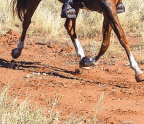
It’s one thing to be on the leading edge of change, it’s another being 30 years ahead of your time. For one equine practitioner, a realization about the nature of traditional deworming practices and a crusade to change them put him decades ahead of the rest of the horse industry.
The story begins in 1991, when John Byrd, DVM, was an equine veterinarian with a solo practice in Southern California. Like most veterinarians, Byrd spent most of his days doing lameness exams, colic calls and suturing the occasional wound. Also like most veterinarians in the United States, he didn’t administer deworming treatments to his patients—his clients did that themselves—but he’d offer advice about timing and products when asked.
“Back then, most owners were worming every two months,” says Byrd. “Because that’s what the manufacturers told us was necessary. I even knew some people who would deworm every time the farrier came to help them remember. That could end up being as often as every six to eight weeks. No one questioned this frequency, under the assumption that parasites were harmful, so regular treatment had to be a good thing.”
However, when a daily deworming product hit the market and owners began asking Byrd about it, he began to wonder about this rote approach to parasite control. “People would ask, ‘Should I give this to my horse between paste treatments?’ And my first thought was how could these horses






